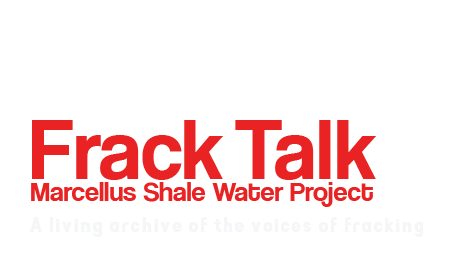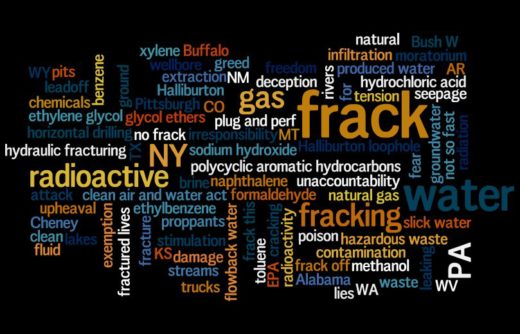Horizontal drilling techniques have allowed one well to access gas at a wider radius by drilling down and then out underneath the earth.
This drilling process began in the 1980s. According to the New York Department of Environmental Conservation, accessing natural gas located deep in the Marcullus Shale formation has been difficult until recently, when the industry combined hydraulic fracturing techniques with horizontal drilling. Recent technology has also allowed the strategic placing of fractures at specific points in the shale, enabling greater gas extraction efficiency.
19,000 new natural gas wells were drilled in 2009 to total 512,000 producing wells in the United States. Click here for information on well growth in your state.
This New York Times Interactive Feature demonstrates the hydraulic fracturing process. This feature shows the above-ground layout of a well site.
Although the safety of fracking is widely questioned, the number of wells is growing. 3,300 Marcellus gas-well permits were issued in Pennsylvania last year, compared to 117 in 2007. The industry estimates that 50,000 new wells will be drilled in Pennsylvania in the coming decade.
FLUID
The fluid usually contains a large amount of water as well as proppants (sand or ceramic beads intended to keep the fractures open) and chemicals.
As much as 20%-40% of the fracking fluid can remain underground, allowing the drilling to affect the water for years.
Wastewater is sometimes disposed of at sewage plants that are not designed to treat the chemicals found in the fracking fluid. This wastewater can then be disposed of in nearby rivers.
The remaining fluid is pumped back out into pits above ground that are either unlined or lined with material that can easily tear and allow the chemicals to seem back into the ground. In the last three years 16 wells in Pennsylvania reported spills or leaks in wastewater pits.
Fracking for a single well can require anywhere from 50,000 to 350,000 gallons of fracturing fluids, and from 75,000 to 320,000 pounds of proppants.
Natural gas companies refuse to reveal complete lists of the components of their fracking fluid for “proprietary” reasons. However, the EPA identified some of the following chemicals: benzene, ethylbenzene, toluene, xylene, naphthalene and other chemicals; polycyclic aromatic hydrocarbons; methanol; formaldehyde; ethylene glycol; glycol ethers; hydrochloric acid; and sodium hydroxide. Here is a chart of some of the chemicals the EPA found in fracking fluids. The EPA found nine chemicals that were used in amounts that pose a threat to human health, and those chemicals ranged from 4 to 13,000 times the concentrations acceptable for human drinking water. Despite this, the EPA ruled in 2004 that there was no evidence of health risk and no further study was needed.
The EPA also found that these fluids were sometimes injected directly into underground sources of drinking water. (At least 10 states-Alabama, Arkansas, Colorado, Kansas, Montana, New Mexico, Virginia, Washington, West Virginia and Wyoming- contain coal formations with drinking water aquifers.)
Of the 1.3 billion gallons of drilling wastewater produced by Pennsylvania wells over the past three years, most was treated at plants unequipped to remove many of the toxic materials in the waste.
Residents of drilling areas are not informed of the chemicals used in the fracking process.
The chemicals injected into the earth are only part of the pollution problem. Fracking also releases heavy metals naturally found in the shale (strontium, barium, uranium, and radium–some of which are also naturally occurring radioactive materials).
This map from the New York Times shows contamination in Pennsylvania from hydraulically fracked natural gas wells.
GOVERNMENT REGULATION
In 2005 Congress passed the Energy Policy Act of 2005. It created a loophole exempting the oil and gas industry from the regulations of the Safe Drinking Water Act, making it the only industry allowed to inject fluids into groundwater without regulation by the Environmental Protection Agency (EPA). The loophole exempts companies (including Halliburton) from disclosing the chemicals involved in fracking operations that would normally be required under federal clean water laws. The loophole is commonly known as the “Halliburton loophole,” as it passed at the urging of former Halliburton CEO and then Vice-President Dick Cheney. In that same year, Halliburton patentented its new fracking process. It is the industry leader in natural gas drilling.
The FRAC (Fracturing Responsibility and Awareness of Chemicals) Act, proposed in 2009, aims to repeal fracking’s exemption from the Safe drinking Water Act, and make oil and gas companies report the chemicals they use.
On January 5, 2011, members of Congress’s Natural Gas Caucus sent a letter to Interior Secretary Ken Salazar asking him to refrain from imposing regulations on natural gas drilling. The Caucus’s 32 members received $1,742,572 in campaign funding from the oil and gas industry between 2009 and 2010, at an average of $54,455 per candidate.
MORE PROBLEMS
Fracking has been the suspect in at least five states (Colorado, Ohio, Pennsylvania, Texas and West Virginia) where natural gas leaked into drinking water supplies.
Wastewater with radioactive matierals entering the water table and being dumped into rivers affects more than drinking water. This also impacts the fishing and farming industry and what we eat as well as what we drink.
Fracking also affects air quality. Wyoming, the least populated state, failed to meet federal air quality standards in 2009 for the first time due to fumes released from wells.
Hospitals in areas in Texas with the highest concentration of wells reported a 25 percent asthma rate for young children, while the Texas state rate is 7 percent.
Some wells have produced wastewater containing levels of radioactive elements 100 times higher than federal drinking-water standards, while others have contained 1,000 times the amount of acceptable radioactive elements.
In terms of global climate change, the natural gas drilling issue is still about natural gas, a non-renewable fossil fuel that produces carbon dioxide when it is burned. In addition, when natural gas is produced, transported, and stored in the US, 3% and 5% of it leaks into the atmosphere. Natural gas is a much more potent greenhouse gas than carbon dioxide, so even a relatively small percentage leak on a very large volume of gas has a large impact on greenhouse gas emissions, and thus, affects climate change.
Read the New York Times article
Read federal and state documents obtained by the New York Times.
http://www.rodale.com/fracking-0
http://www.earthworksaction.org/publications.cfm?pubID=145
http://www.earthworksaction.org/FracingDetails.cfm
http://www.earthworksaction.org/hydfracking.cfm
http://en.wikipedia.org/wiki/Hydraulic_fracturing
http://en.wikipedia.org/wiki/Fracturing_Responsibility_and_Awareness_of_Chemicals_Act
http://www.propublica.org/article/opponents-to-fracking-disclosure-take-big-money-from-industry
http://www.halliburton.com/AboutUs/default.aspx?pageid=2720&navid=981
http://www2.parl.gc.ca/HousePublications/Publication.aspx?DocId=4918403&Language=E&Mode=1&Parl=40&Ses=3#Int-3707988


